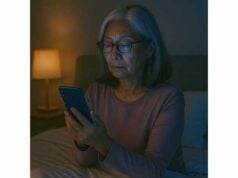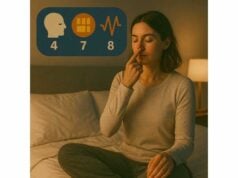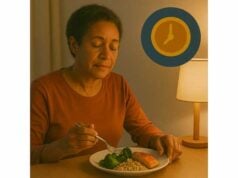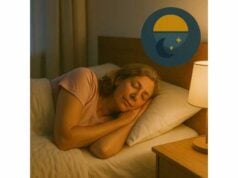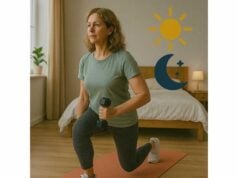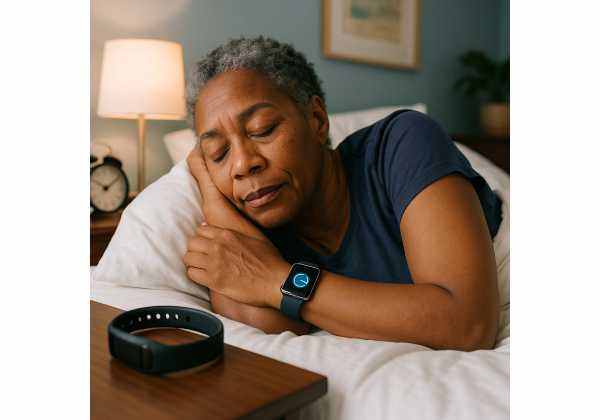
Wearables promise clarity about the one-third of life we spend asleep. In midlife and older adulthood, they can flag patterns you feel but cannot see: late meals pushing your heart rate up, a hot bedroom clipping deep sleep, or restless nights after evening alcohol. Yet devices also add noise—stage estimates that change nightly, “readiness” scores that don’t match how you feel, and buzzing alerts that raise anxiety. This guide shows you how to turn sleep data into useful action while ignoring the metrics that distract. You’ll learn what numbers matter, how to handle accuracy caveats, and when to escalate beyond consumer tech. For a broader view of how nightly recovery fits into healthy longevity, see our pillar on sleep, stress, and recovery. Then use the frameworks below to track fewer, better metrics—so your device becomes a coach, not a critic.
Table of Contents
- Sleep Metrics 101: Time Asleep, Efficiency, and Staging
- Accuracy Caveats: Optical Sensors and Movement Artifacts
- Trends Over Time Versus Night to Night Noise
- Setting Useful Alerts and Turning Off Anxiety Triggers
- Linking Data to Habits: Light, Meals, Exercise, and Bedtime
- Protecting Privacy and Battery Life Best Practices
- When to Seek Clinical Testing Beyond a Wearable
Sleep Metrics 101: Time Asleep, Efficiency, and Staging
Consumer wearables translate movement and optical signals into sleep estimates. To use them well, separate foundational metrics—those that guide behavior—from fragile metrics that are easy to misread.
Foundational metrics
- Time Asleep (Total Sleep Time): The backbone metric. It integrates bedtime, wake time, naps, illness, and travel stress. Track the 7–14 day average, not a single night. Adults generally do best with ~7–9 hours in bed to net 6.5–8 hours asleep, depending on sleep efficiency and age-related changes.
- Sleep Efficiency (SE): Minutes asleep divided by minutes in bed. A healthy range for many midlife adults is 85–92%. Below ~80% for weeks suggests fragmentation; above ~95% often signals a short time in bed rather than perfect sleep. Treat SE as a trend, not a grade.
- Sleep Timing and Regularity: Bedtime and wake time variability (the spread across a week). Keeping both within ±60 minutes is one of the strongest, simplest levers for better nights.
- Nocturnal Resting Heart Rate (RHR): A proxy for overnight load and recovery. Look for a smooth drop after lights-out and a lower mid-night plateau on cooler, alcohol-free nights.
- Heart Rate Variability (HRV): A trend indicator of autonomic balance. Higher averages (for you) tend to accompany calmer evenings, earlier meals, and cooler rooms.
Fragile metrics (use sparingly)
- Sleep Staging (Light/Deep/REM): Wearables estimate stages using movement and optical signals. They are directionally useful—cooler nights often show more deep sleep; late alcohol often reduces REM—but absolute minutes are noisy. Use staging to validate patterns, not to hit nightly quotas.
- Single “Readiness” or “Recovery” Scores: These can help when they align with how you feel and with context (travel, illness). If they routinely conflict with your experience, stop checking daily and focus on individual components (RHR, HRV, timing).
A practical hierarchy
- First month: Emphasize sleep opportunity (time in bed), timing regularity, and morning light exposure.
- Second month: Add RHR and HRV trends.
- Only after consistency: Glance at staging patterns to fine-tune temperature, alcohol, and late exercise.
How to read a night graph
- A gentle RHR slope down in the first half usually means good alignment of timing and temperature.
- A late RHR nadir (lowest point) suggests late meals or alcohol.
- Frequent movement spikes can reflect pain, room noise, pets, or back-sleeping if snoring is an issue.
Wearables are best at telling you whether your inputs (light, meals, exercise, bedtime) support recovery. Let the simple metrics guide those inputs; treat everything else as optional detail.
Accuracy Caveats: Optical Sensors and Movement Artifacts
Every wearable makes trade-offs. Understanding your device’s sensor limits prevents misinterpretation and overreacting to nightly swings.
Optical heart sensors (PPG) basics
Wrist and finger devices shine light into the skin and measure changes in reflected light with each heartbeat. Accuracy is typically highest at rest and during stable sleep, and more variable during movement, at colder temperatures, or when fit is loose. Darker tattoos, heavy arm hair, and certain skin tones can influence signal quality depending on wavelength and sensor design. During sleep, PPG’s strength is nocturnal RHR; HRV captures are decent when motion is minimal, but one-off nightly values can jump with artifacts.
Accelerometers and sleep/wake detection
Most devices lean on movement to infer sleep. This is why watches often overestimate total sleep in people who lie still while awake and underestimate wake after sleep onset—especially in older adults who rest quietly at night. Expect better detection of sleep onset than brief awakenings.
Sleep staging limitations
Consumer algorithms estimate stages using a blend of motion, heart rate, and derived respiration. Compared to lab polysomnography (EEG, EOG, EMG), staging accuracy is moderate: decent at distinguishing sleep vs wake, variable for light vs deep, and least reliable for REM onset. That’s fine for trend spotting (e.g., alcohol reducing second-half sleep quality) but not for medical decisions.
Common artifacts and how to reduce them
- Loose fit: Fasten snugly at night; rings should fit secure but comfortable.
- Cold hands: Peripheral vasoconstriction weakens PPG; warm your hands before bed if your device often loses signal.
- Motion bursts: Rolling over or restless legs can create false spikes; rely on weekly averages over single nights.
- Charging gaps: Partial nights skew averages. Keep a charging routine (see Section 6).
Population considerations in aging
- Lower peripheral perfusion and thinner skin can alter signal quality; finger-based sensors may beat wrist sensors for RHR at night in some users.
- Comorbid conditions (atrial fibrillation, frequent ectopy) and beta-blockers can distort HRV estimates. Use HRV primarily as a trend; when in doubt, prioritize RHR and how you feel.
- Pain, neuropathy, and nocturia increase movement artifacts. If your device shows choppy nights that you do not perceive, check practical causes (room temperature, pain flares, bathroom trips) before changing habits.
How to set expectations
- Use your device to test behavioral levers—dinner timing, alcohol, light, temperature—and confirm patterns over weeks.
- For meaningfully higher precision (diagnosis, oxygen saturation during events), see Section 7 about clinical testing.
- For stage interpretation basics and how deep and REM map to behavior changes, skim stage-aware sleep targets.
Accuracy matters—but only to the extent that it changes actions. The right response to noisy staging is not more staring at charts; it is focusing on input levers that consistently improve the easy-to-measure metrics.
Trends Over Time Versus Night to Night Noise
A single night is a story fragment. In midlife, stress spikes, late dinners, pain flares, and travel can swing numbers without reflecting your usual pattern. The cure is trend thinking: track fewer metrics, summarized weekly, and judge by direction rather than individual points.
Build a two-level dashboard
- Daily check (30 seconds): Did you meet your sleep opportunity (time in bed)? How do you feel mid-morning (0–10)? Anything unusual (alcohol, heavy meal, late exercise)?
- Weekly review (5 minutes): Look at 7-day averages for Time Asleep, sleep efficiency, RHR, and (optionally) HRV. Note the lowest RHR night: was it a cooler, earlier dinner? Capture that recipe.
How to run clean A/B tests
- Choose one lever per week (e.g., earlier dinner by 90 minutes).
- Hold everything else steady.
- Compare two similar weeks. You are looking for ~3–5 bpm lower RHR mid-night or a 5–10% drop in time awake after sleep onset—not perfection.
- Decide and move on. Keep what works; discard what doesn’t.
Reading HRV the right way
- Think in 28-day rolling averages rather than nightly peaks.
- Compare you to you across seasons; ignore friend comparisons.
- If HRV dips for 3–5 nights with elevated RHR, ask: illness? heat? alcohol? travel? training overload? Correct the obvious first.
Use staging only to confirm lever effects
- Cooler rooms and earlier dinners often increase slow-wave consolidation in the first half.
- Alcohol and late screens often reduce second-half quality where REM clusters.
- Do not chase stage minutes; chase inputs that consistently lower RHR and raise next-day energy.
Minimalist scorecard for aging well with wearables
- Time in bed (goal window): within ±30–60 minutes of a consistent target.
- Average RHR: drifting down or stable in your healthy range.
- Subjective energy/mood: more days at 6–8/10.
- Optionally HRV: stable or inching up over months.
For context on interpreting HRV in the bigger picture of longevity, see HRV fundamentals. Let trend lines, not flashy nightly labels, drive your next experiment.
Setting Useful Alerts and Turning Off Anxiety Triggers
Notifications should prevent mistakes, not create stress. The wrong alerts keep you staring at your wrist; the right ones quietly support better choices.
Turn on only what drives action
- Low battery reminders timed for your charging window (e.g., after lunch).
- Inactivity nudges every 60–90 minutes during work blocks to insert a 2–3 minute movement snack—shoulders, squats, quick walk.
- Bedtime cue 60–90 minutes before lights-out to begin your wind down (dim lights, close loops, short breathing practice).
- Morning light reminder soon after wake time if you routinely skip daylight exposure.
Turn off anxiety triggers
- Nightly “sleep score” alerts. They bias attention toward outcomes rather than inputs and can worsen performance anxiety.
- Stage-by-stage notifications. You do not need to know you “only got 47 minutes of deep sleep” at 7 a.m. on Tuesday. Use weekly reviews.
- Competitive leaderboards late in the day. Comparing steps and rings at 10 p.m. is a recipe for bedtime drift.
Use haptics and summaries, not constant pings
- Let the device stay silent during wind down and sleep.
- Replace daily “sleep score” pings with a Sunday summary: average Time Asleep, RHR pattern, wins to keep (earlier dinner, cooler room), and one lever to try next.
Create guardrails for “orthosomnia” (sleep-data obsession)
- No morning doom-scrolling through stages. Check only Time Asleep, RHR, and a quick energy rating.
- No device-driven bedtime shifts. Do not push bedtime later to chase an arbitrary readiness number.
- Cap daily checks at one glance; reserve deep dives for weekly reviews.
Pair alerts with coping tools
If data sometimes spike worry, bundle your bedtime cue with a 2–5 minute breathing set (e.g., inhale 4 seconds, exhale 6). If rumination is your pattern, schedule worry time in late afternoon and park open loops before dinner. For a structured approach to lowering evening arousal, skim stress downshift strategies and pick one to test this week.
Your device should feel like a calm coworker, not a supervisor. Design alerts to support doable behaviors and silence anything that does not lead to a specific action.
Linking Data to Habits: Light, Meals, Exercise, and Bedtime
Wearables are most valuable when they close the loop between behavior and biology. Use your nightly graphs to decide what to do today, not just how to feel about last night.
Light
- Morning exposure (10–30 minutes): Track how a week of early light shifts your wake time consistency and mid-morning energy. Many users see steadier wake times and easier sleep onset within 7–10 days.
- Evening dimming (last 2–3 hours): Watch for earlier RHR decline and fewer late-night awakenings when you reduce brightness (not only blue light).
- For practical circadian wins, including screen hygiene, see morning light and evening darkness.
Meals and alcohol
- Dinner timing: Aim for the last full meal 2–3 hours before bed. Look for a mid-night RHR nadir that arrives earlier and a smoother curve when you hit this window.
- Alcohol timing: Finish 3–4 hours before lights-out on nights you choose to drink. Expect slightly higher RHR; plan an earlier bedtime the following night to recover.
Exercise
- Morning or midday moderate activity tends to improve first-half sleep depth without heating the evening.
- Evening vigorous sessions can work if you cool down, rehydrate, and finish 2–3 hours before bed. Use your device to confirm: if RHR stays high past midnight, move intensity earlier.
Temperature
- Set the bedroom slightly cool at lights-out. Many users see more consolidated first-half sleep and earlier RHR troughs on cooler nights.
- Warm shower 60–90 minutes before bed can trigger a helpful cooling response.
Position and snoring
- If your wearable tracks snoring minutes or captures audio via the phone, test head-of-bed elevation or side-sleeping for a week. Look for fewer movement spikes and a steadier RHR pattern.
Design a four-week experiment
- Week 1: Lock wake time and morning light; review Time Asleep and energy.
- Week 2: Move dinner earlier; add a modest evening dimming routine.
- Week 3: Shift the hardest workout earlier; keep easy mobility in the evening.
- Week 4: Optimize bedroom temperature; consider a breathable comforter or pajamas.
Each Sunday, choose one keeper (a habit that clearly helped) and one new lever to test. Your dashboard should tell a story of small, steady improvements, not perfection.
Protecting Privacy and Battery Life Best Practices
Your health data is valuable. Treat it like a bank account: know where it goes, limit permissions, and keep a routine that prevents surprise drains—on privacy and battery.
Privacy hygiene
- Audit permissions quarterly. In your phone’s settings and within the wearable app, review which apps can read your sleep, heart rate, and location. Revoke anything you do not use.
- Use local-first features when possible. Many devices can compute basic metrics on-device and sync summaries later. Turn off continuous location sharing unless you need it (e.g., safety features).
- Control data sharing. If your device offers “community” or “research” programs, read the data use details. Opt in only if you are comfortable with anonymization, retention periods, and whether data may be sold.
- Backups and exports. Periodically export your sleep summaries (CSV or PDF) and store them in a secure cloud or encrypted drive. If you change devices, you will retain your trend data.
- Account security. Enable two-factor authentication. Use a unique, strong password in a manager. If available, set a device passcode separate from your phone.
Battery-life strategies
- Charge at the same times each day to avoid partial nights: during morning coffee or after lunch for 20–40 minutes often keeps rings/watches above ~30–50% through the night.
- Night power modes. Many devices offer sleep mode that limits notifications, screen wake, and background services; this saves battery and reduces disturbances.
- Sensor tuning. Turn off continuous SpO₂ unless you and your clinician are watching it; it significantly drains battery and can be noisy without clinical context.
- Avoid extreme temperatures. Heat degrades battery health; remove the device for saunas and very hot tubs unless the manufacturer explicitly supports it.
- Firmware updates on a schedule. Update weekly or monthly, not at 10 p.m. when you need the device ready for the night.
Data you do not need to share
- Employer wellness challenges sometimes request continuous data. Share only aggregated step counts or time-in-zone if you participate; decline heart rate and sleep exports.
- Social media screenshots can invite comparison and pressure. If you share at all, share process (“earlier dinner helped this week”) rather than raw scores.
Think of privacy and battery as the quiet infrastructure behind good sleep tracking. When both are stable, you can focus on the inputs that matter rather than troubleshooting at bedtime.
When to Seek Clinical Testing Beyond a Wearable
Wearables are great for habits; clinics are for diagnosis. Know when to escalate so you don’t spend months tweaking bedtime when a treatable condition is the real issue.
Strong reasons to seek evaluation
- Loud snoring with witnessed pauses, gasping, or choking; morning headaches; unrefreshing sleep.
- Excessive daytime sleepiness affecting driving or work despite adequate time in bed.
- Persistent insomnia (≥3 nights/week for ≥3 months) with daytime impairment—especially if you have already improved light, timing, and caffeine.
- Restless legs (urge to move, worse at night, relieved by movement) or bed partner reports of kicks.
- Cardio-metabolic red flags (resistant hypertension, atrial fibrillation, insulin resistance) alongside unrefreshing sleep or snoring.
- Dream enactment (talking, punching, falling out of bed) suggesting REM behavior disorder.
- Chronic lung or neuromuscular disease with morning headaches or night-time breathlessness.
What testing looks like
- Home sleep apnea testing (HSAT): Comfortable first step for suspected obstructive sleep apnea (OSA). It estimates breathing events and oxygen levels at home.
- In-lab polysomnography (PSG): Gold standard when HSAT is negative but suspicion remains, when other disorders are likely, or when limb movements or parasomnias need characterization.
- Actigraphy (medical-grade motion tracking) can document circadian rhythm disorders or insomnia patterns when diaries are insufficient.
Preparing for a visit
- Bring a two-week log of bedtime/wake time, naps, alcohol, caffeine, dinner timing, and exercise.
- Export sleep summaries (time asleep, efficiency, RHR/HRV averages) rather than nightly staging. Clinicians care about patterns.
- List medications and supplements with doses and timing; several influence sleep, heart rate, and nocturia.
After diagnosis
- OSA: Expect discussion of CPAP, oral appliance therapy, or positional strategies. Wearables can still help you see behavior effects (weight loss, alcohol timing).
- Insomnia: Cognitive Behavioral Therapy for Insomnia (CBT-I) remains first-line for chronic insomnia; you can use your wearable to track time in bed and sleep opportunity as you implement it.
- Restless legs: Iron studies and targeted therapies can be life-changing; devices may show fewer movement spikes after treatment.
Wearables are excellent scouts. If your scout keeps reporting trouble—despite disciplined inputs—bring in the specialists. Clear diagnosis transforms both sleep and the meaning of your data.
References
- Evaluating reliability in wearable devices for sleep staging 2024 (Scoping Review)
- Accuracy of Three Commercial Wearable Devices for Estimating Sleep Stages and Sleep Metrics Compared with Polysomnography 2024 (Validation Study)
- Accuracy of Heart Rate Measurement with Wrist-Worn Wearable Devices Across Skin Tones: A Systematic Review and Meta-Analysis 2022 (Systematic Review and Meta-analysis)
- Wearable technologies for health research 2023 (Review)
- Assessing the Accuracy of Four Heart Rate Wearables and One Research-Grade Device 2025 (Validation Study)
Disclaimer
This article provides general information about using consumer wearables to support sleep and recovery. It is not a substitute for personal medical advice, diagnosis, or treatment. If you experience persistent insomnia, excessive daytime sleepiness, loud snoring with breathing pauses, or symptoms that affect safety, seek professional evaluation. Discuss device data, medications, and new routines with your clinician, especially if you manage cardiovascular, respiratory, or neurological conditions.
If you found this guide helpful, please consider sharing it on Facebook, X, or your preferred platform, and follow us on social media. Your support helps us continue creating careful, evidence-based resources.

